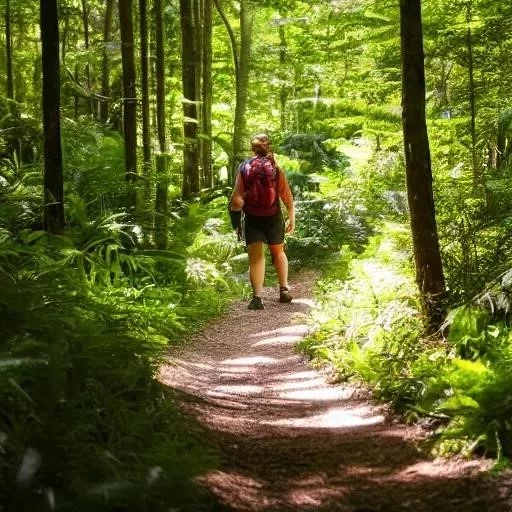
Modern life, a relentless torrent of deadlines and digital notifications, has cast a long shadow over our collective well-being. The pervasive hum of stress, a constant companion for many, silently erodes our mental and physical health, leaving countless individuals feeling perpetually overwhelmed and disconnected. Yet, amidst this cacophony, a remarkably simple and profoundly effective remedy beckons, offering a potent antidote to our hurried existence: the ancient, invigorating practice of hiking. This isn’t merely a pastime; it’s a powerful prescription for peace, a transformative journey offering an undeniable escape from the pressures of contemporary life.
Leading researchers and seasoned psychologists are increasingly spotlighting the astonishing therapeutic potential embedded within spending dedicated time in natural environments. By integrating insights from cutting-edge neuroscience and centuries of anecdotal wisdom, we are discovering that the act of traversing winding trails, surrounded by the Earth’s raw beauty, directly impacts our physiological and psychological states. Indeed, the science is overwhelmingly clear: reconnecting with the wild outdoors, particularly through sustained physical activity like hiking, serves as an incredibly effective mechanism for de-stressing and recalibrating the mind, fostering a profound sense of tranquility often elusive in our daily grind.
Key Benefits of Hiking for Stress Reduction
For those seeking tangible evidence, here’s a summary of why hitting the trails is an unparalleled strategy for mental and physical rejuvenation:
| Aspect | Description | Scientific Backing / Reference |
|---|---|---|
| Nature Exposure (Biophilia) | Our inherent human tendency to connect with nature. Exposure to natural sights, sounds, and smells reduces mental fatigue and boosts mood. | Studies on “Shinrin-yoku” (Forest Bathing) demonstrate reduced stress hormones and improved immune function. |
| Physiological Benefits | Physical exertion lowers cortisol levels (the primary stress hormone), reduces blood pressure, and improves heart rate variability. | Research published in Environmental Health and Preventive Medicine shows significant drops in stress markers after forest walks. |
| Psychological Benefits | Fosters mindfulness, provides a sense of accomplishment, and distracts from rumination. Enhances feelings of calm and positive self-perception. | University of Michigan studies suggest spending time in nature can reduce negative thought patterns and improve cognitive function. |
| Neurological Impact | Increases alpha brain waves, associated with states of relaxation and heightened creativity. Natural environments promote “soft fascination.” | Neuroscientific findings indicate that natural settings activate brain regions linked to empathy and emotional stability, while quieting those associated with fear. |
| Practical Recommendation | Start with shorter, easier trails and gradually increase duration and difficulty. Aim for at least 20-30 minutes, three times a week. | National Park Service resources advocate for regular outdoor activity for overall well-being. |
The remarkable impact of immersing oneself in nature, often dubbed “forest bathing” or Shinrin-yoku, extends far beyond mere anecdotal relief. Scientific inquiries, rigorously conducted across various prestigious institutions, consistently reveal a tangible reduction in physiological stress markers. Cortisol levels, the notorious hormones of stress, demonstrably plummet after even moderate periods spent amidst trees and tranquil landscapes. Simultaneously, blood pressure readings decrease, and heart rate variability—a key indicator of a resilient nervous system—improves significantly. This isn’t just feeling better; it’s your body actively recalibrating, moving towards a healthier, more balanced equilibrium.
Beyond these measurable biological shifts, the psychological benefits are equally profound. Hiking offers a unique opportunity for mindful engagement, drawing our attention away from the incessant demands of our digital lives and anchoring us firmly in the present moment. The rhythmic crunch of leaves underfoot, the crisp scent of pine, the panoramic vistas unfolding before our eyes—these sensory inputs collaboratively work to quiet the incessant chatter of an overstimulated mind. This intentional disengagement from daily stressors allows for mental clarity, fostering a renewed sense of perspective and promoting genuine emotional resilience. It’s a powerful reset button for the soul, enhancing creativity and problem-solving capacities previously obscured by daily pressures.
Moreover, the inherent challenge of navigating a trail, however gentle, instills a powerful sense of accomplishment. Conquering a steep ascent or simply completing a planned route, particularly after a stressful week, provides a tangible boost to self-esteem and confidence. This feeling of mastery, coupled with the physical exertion, triggers the release of endorphins, our body’s natural mood elevators, leaving hikers feeling invigorated, refreshed, and undeniably optimistic about facing future challenges. It’s an empowering cycle: the more you hike, the stronger you feel, both physically and mentally, creating a virtuous loop of well-being.
Looking forward, as our world continues its rapid technological evolution, the imperative to intentionally disconnect and seek solace in nature will only grow stronger. Forward-thinking companies are even exploring “nature prescriptions” for employees, recognizing the undeniable link between outdoor activity and enhanced productivity, creativity, and overall employee satisfaction. The trail, once just a path, is transforming into a crucial pathway to mental wellness, a universally accessible resource for cultivating inner peace and robust health. Embracing hiking is not just about physical fitness; it’s about investing in a future where clarity, calm, and connection are not luxuries, but fundamental components of a well-lived life. So, lace up your boots, step outside, and discover the extraordinary power awaiting you on the path less traveled.
